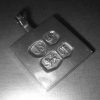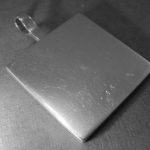Description
Jack Spencer, a silver Sheffield bicentennial ingot pendant, Sheffield 1973, stamped JS in a shield for Jack Spencer, numbered 33, the feature hallmark panel 2.7 cm square, 3.9 cm long including the fixed bale SOLD
1973 being the bicentenary of Sheffield being granted an Assay Office and the date letter used to celebrate the fact was a replica of the very first letter, as seen here. Both Jack Spencer and Colin Rockingham (Sales Director of Jack Spencer (Goldsmiths) Ltd) maintain that Jack Spencer was the first, if not one of the first, to make ‘feature hallmark’ jewellery. We see here they appear in 1973, whereas one sees many manufacturers utilising ‘feature hallmarks’ by 1977, in conjunction with the Silver Jubilee mark. This point in time being arguably the zenith of the practise. Mr Rockingham tells me that the demand was such that Jack approached the Sheffield Assay Office Master requesting that a special single punch was made to deliver the marks in a precise spacing to the pieces. This, after a little deliberation, was agreed. Jack was also prompted to register elsewhere, such as Edinburgh. It has been suggested that he also registered at Birmingham. Mr Rockingham also stated that items marked with the Edinburgh assay found more of a ready market north of the border to locals and tourists alike, through their stockists there, such as Hamilton & Inches of Edinburgh.







